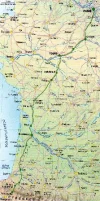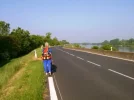26th May 2004:
The lady in the Tourist office told us not to walk on the N137 to Mirambeau as it was not safe. She said to rather take the Chemin St Jacques trail which is very well marked with scallop shells on concrete 'steles' along the way. 'It is only 25kms' she told us.
The first stele we came across after walking about 2km out of town said '31Kms' to Mirambeau and pointed straight onto a path between a wheat field and a vineyard. So we climbed through head high vegetation, grass so high that we had to frog march with high knees to get through, wobble along stony paths through vineyards and past farmer's barns and through a Stainbank-like forest.
Then we were sent through hard, lumpy recently ploughed ground, through field after field. Not one person, no villages, no signs, no shops, just ploughed fields. 33kms to Mirambeau. We were pooped when we finally arrived at about 3.30pm and for the first time were both GAT VOL of Chemin signs and fields!





















